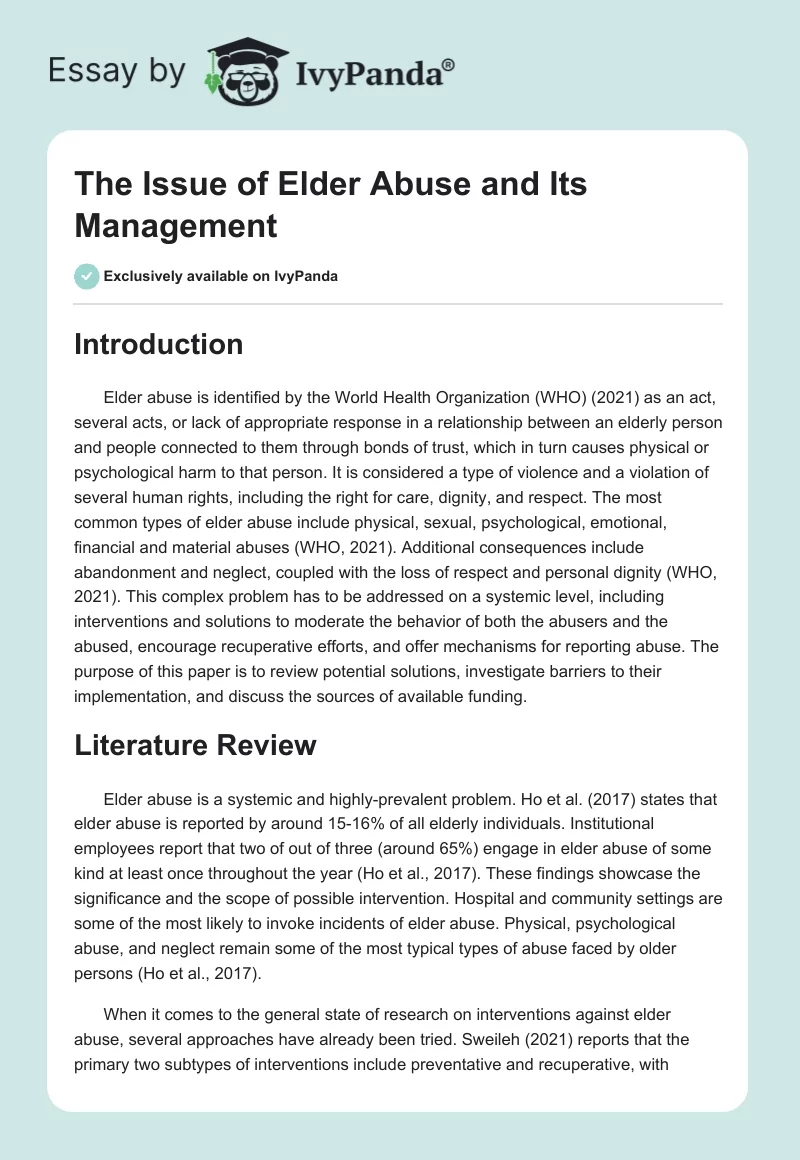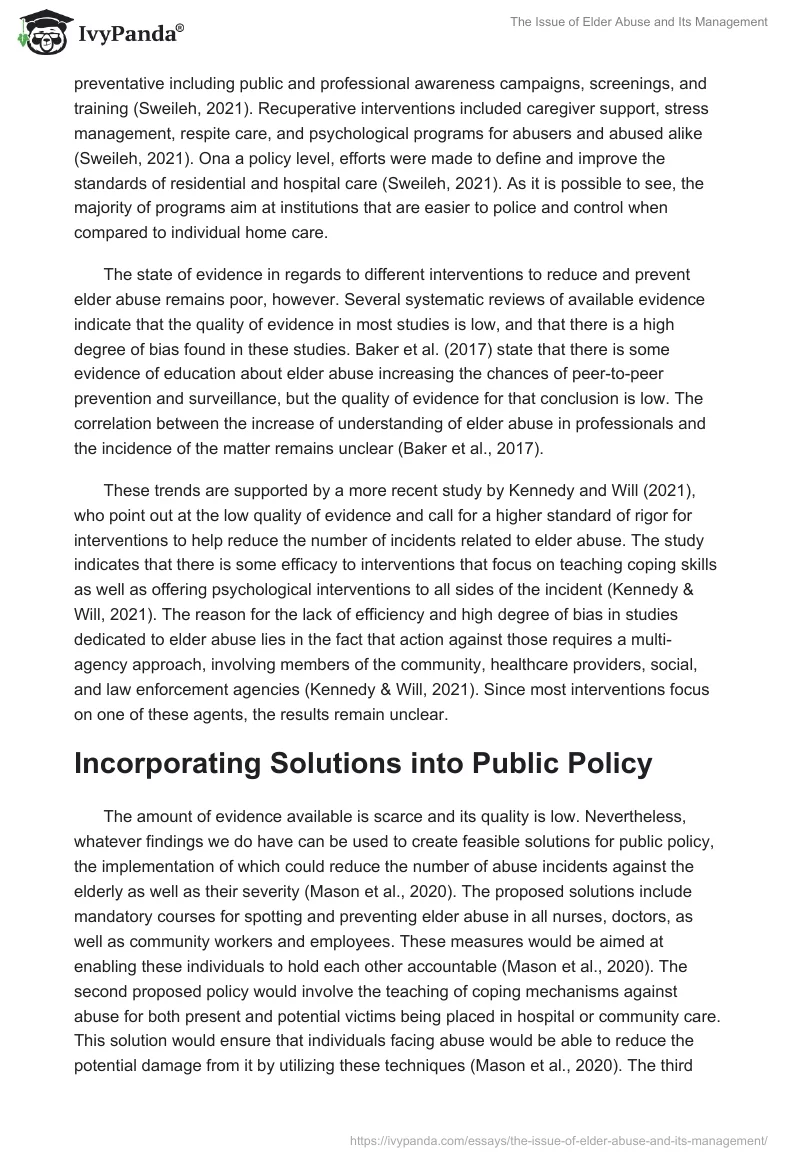Introduction
Elder abuse is identified by the World Health Organization (WHO) (2021) as an act, several acts, or lack of appropriate response in a relationship between an elderly person and people connected to them through bonds of trust, which in turn causes physical or psychological harm to that person. It is considered a type of violence and a violation of several human rights, including the right for care, dignity, and respect. The most common types of elder abuse include physical, sexual, psychological, emotional, financial and material abuses (WHO, 2021). Additional consequences include abandonment and neglect, coupled with the loss of respect and personal dignity (WHO, 2021). This complex problem has to be addressed on a systemic level, including interventions and solutions to moderate the behavior of both the abusers and the abused, encourage recuperative efforts, and offer mechanisms for reporting abuse. The purpose of this paper is to review potential solutions, investigate barriers to their implementation, and discuss the sources of available funding.
Literature Review
Elder abuse is a systemic and highly-prevalent problem. Ho et al. (2017) states that elder abuse is reported by around 15-16% of all elderly individuals. Institutional employees report that two of out of three (around 65%) engage in elder abuse of some kind at least once throughout the year (Ho et al., 2017). These findings showcase the significance and the scope of possible intervention. Hospital and community settings are some of the most likely to invoke incidents of elder abuse. Physical, psychological abuse, and neglect remain some of the most typical types of abuse faced by older persons (Ho et al., 2017).
When it comes to the general state of research on interventions against elder abuse, several approaches have already been tried. Sweileh (2021) reports that the primary two subtypes of interventions include preventative and recuperative, with preventative including public and professional awareness campaigns, screenings, and training (Sweileh, 2021). Recuperative interventions included caregiver support, stress management, respite care, and psychological programs for abusers and abused alike (Sweileh, 2021). Ona a policy level, efforts were made to define and improve the standards of residential and hospital care (Sweileh, 2021). As it is possible to see, the majority of programs aim at institutions that are easier to police and control when compared to individual home care.
The state of evidence in regards to different interventions to reduce and prevent elder abuse remains poor, however. Several systematic reviews of available evidence indicate that the quality of evidence in most studies is low, and that there is a high degree of bias found in these studies. Baker et al. (2017) state that there is some evidence of education about elder abuse increasing the chances of peer-to-peer prevention and surveillance, but the quality of evidence for that conclusion is low. The correlation between the increase of understanding of elder abuse in professionals and the incidence of the matter remains unclear (Baker et al., 2017).
These trends are supported by a more recent study by Kennedy and Will (2021), who point out at the low quality of evidence and call for a higher standard of rigor for interventions to help reduce the number of incidents related to elder abuse. The study indicates that there is some efficacy to interventions that focus on teaching coping skills as well as offering psychological interventions to all sides of the incident (Kennedy & Will, 2021). The reason for the lack of efficiency and high degree of bias in studies dedicated to elder abuse lies in the fact that action against those requires a multi-agency approach, involving members of the community, healthcare providers, social, and law enforcement agencies (Kennedy & Will, 2021). Since most interventions focus on one of these agents, the results remain unclear.
Incorporating Solutions into Public Policy
The amount of evidence available is scarce and its quality is low. Nevertheless, whatever findings we do have can be used to create feasible solutions for public policy, the implementation of which could reduce the number of abuse incidents against the elderly as well as their severity (Mason et al., 2020). The proposed solutions include mandatory courses for spotting and preventing elder abuse in all nurses, doctors, as well as community workers and employees. These measures would be aimed at enabling these individuals to hold each other accountable (Mason et al., 2020). The second proposed policy would involve the teaching of coping mechanisms against abuse for both present and potential victims being placed in hospital or community care. This solution would ensure that individuals facing abuse would be able to reduce the potential damage from it by utilizing these techniques (Mason et al., 2020). The third solution would involve therapy for abused and abusers, to help minimize the damage done and prevent incidents in the future. All of these measures could be implemented holistically or separate, on a policy level, with the latter being potentially easier to sustain.
Potential Barriers
Some of the potential barriers against the proposed measures could include financing troubles, logistical issues as well as political opposition. All three measures constitute either teaching, preventative, or restorative solutions, which would require space, finances, and personnel (Altridge et al., 2016). As it stands, most hospitals are understaffed, making it hard to find personnel for the effort. Acquiring financial aid would likely involve either government support or working with an NGO, and getting approved by either would take time (Altridge et al., 2016). Finally, some nurses and community actors might be opposed to being given courses to prevent and spot elder abuse, treating it as an assumption that the individuals invited are likely to treat their elders with abuse and disrespect (Altridge et al., 2016). The solutions provided may be less efficient than anticipated because of the scarcity of evidence base about the effectiveness of the proposed measures.
The first two barriers can be overcome by working closely with government agencies and NGOs, with the potential of finding volunteers to perform educative duties. That way, nurses in hospitals and community workers will not be stretched as thin. Public backlash can be avoided if the policymakers are upfront about the intents and purposes of the campaign, not allowing for misinterpretation. Finally, the solution to absent data is in the proposed policies themselves, as they can be changed and evaluated depending on how successful they are.
Options for Public and Private Funding
Options for both private and public funding are available for this campaign. It might be possible to obtain government support and apply for medical grants (Schmitt et al., 2020). In addition, getting affiliated with an influential NGO might give access to their funding as well as human resources to accomplish the goals of the campaign (Schmitt et al., 2020). While elder abuse is not something that can promise private companies and individuals direct returns on businesses, it may be possible to attract private and corporate sponsors using philanthropic arguments and good publicity.
Conclusions
Elder abuse is a significant and widespread issue both in the US and abroad. At the same time, it is very understudied, and reliable data on it is scarce. Information about the effectiveness of various approaches to decreasing elder abuse is low-quality and often biased. The proposed intervention relies around teaching social actors to spot abuse, providing coping mechanisms, and restorative therapy. The funding for this campaign can be acquired from the government, NGOs, and private investors.
References
Aldridge, M. D., Hasselaar, J., Garralda, E., van der Eerden, M., Stevenson, D., McKendrick, K., & Meier, D. E. (2016). Education, implementation, and policy barriers to greater integration of palliative care: A literature review. Palliative Medicine, 30(3), 224-239.
Baker, P. R., Francis, D. P., Mohd Hairi, N. N., Othman, S., & Choo, W. Y. (2017). Interventions for preventing elder abuse: Applying findings of a new Cochrane review. Age and Ageing, 46(3), 346-348.
Ho, C. S., Wong, S. Y., Chiu, M. M., & Ho, R. C. (2017). Global prevalence of elder abuse: A metaanalysis and meta-regression. East Asian Archives of Psychiatry, 27(2), 43-55.
Kennedy, C., & Will, J. (2020). Interventions for preventing abuse in the elderly. International Journal of Nursing Practice, 27(1), e12870.
Mason, D. J., Perez, A., McLemore, M. R., & Dickson, E. (2020). Policy & politics in nursing and health care. Elsevier Health Sciences.
Schmitt, C., Lierse, H., & Obinger, H. (2020). Funding social protection: Mapping and explaining welfare state financing in a global perspective. Global Social Policy, 20(2), 143-164.
Sweileh, W. M. (2021). Global research activity on elder abuse: A bibliometric analysis (1950–2017). Journal of Immigrant and Minority Health, 23, 79-87.


